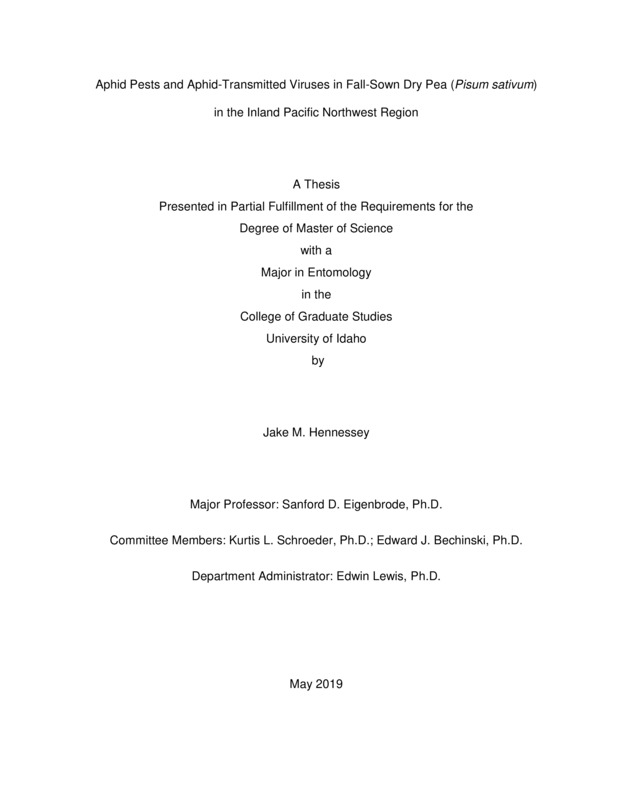Aphid Pests and Aphid-Transmitted Viruses in Fall-Sown Dry Pea (Pisum sativum) in the Inland Pacific Northwest Region
Hennessey, Jake. (2019-05). Aphid Pests and Aphid-Transmitted Viruses in Fall-Sown Dry Pea (Pisum sativum) in the Inland Pacific Northwest Region. Theses and Dissertations Collection, University of Idaho Library Digital Collections. https://www.lib.uidaho.edu/digital/etd/items/hennessey_idaho_0089n_11522.html
- Title:
- Aphid Pests and Aphid-Transmitted Viruses in Fall-Sown Dry Pea (Pisum sativum) in the Inland Pacific Northwest Region
- Author:
- Hennessey, Jake
- Date:
- 2019-05
- Program:
- Plant, Soil and Entomological Sciences
- Subject Category:
- Entomology
- Abstract:
-
Spring-sown dry pea, Pisum sativum, is an important rotational crop grown with wheat in the Palouse region of eastern Washington and northern Idaho. In the lower rainfall regions of the Palouse, spring-sown dry pea are not viable rotational crops. New varieties of dry pea adapted for germination in the fall have proved to be a better alternative to spring-sown pea as rotational crops with wheat in the lower rainfall regions of the Palouse. Pea aphids, Acyrthosiphon pisum (Harris), are a major pest to spring-sown dry pea, in the Palouse region of eastern Washington and northern Idaho. Pea aphids present a threat to dry pea in the region through direct injury from feeding or indirect injury by transmitting viruses, predominantly Pea enation mosaic virus (PEMV) and Bean leaf roll virus (BLRV). The threat of pea aphid to fall-sown dry pea is not known. The general objectives of this thesis were to assess the threat of pea aphid colonization and virus infection in fall-sown dry pea in the Palouse region.
The first objective was to determine if pea aphid abundance and virus status in fall-sown pea locations was different to those in spring-sown pea locations. Virus prevalence within the crop was also compared between the two crops. In a two-year field survey, pea aphids were trapped at both fall-sown and spring-sown pea locations. Aphids were collected and tested for virus. Results showed that aphid abundance and virus status did not differ between fall and spring-sown pea locations. Plant samples were collected from both fall and spring-sown pea locations and tested for virus. Results showed that virus prevalence within the crop also did not differ between fall and spring-sown pea. It is important to note that pea aphids were collected in fall-sown pea locations in the fall of both years of the study, but determined not to be carrying virus. Nonetheless, virus was detected in plant samples collected in the fall from fall-sown pea plants.
The second objective of this study was to determine the relationship between the timing of viruliferous (PEMV) pea aphid inoculations and yield parameters of fall-sown pea. Previous studies indicate that plants inoculated earlier in their development are more prone to a higher yield loss than plants inoculated at later development stages. Experiments took place at the University of Idaho Parker Farm and the University of Idaho Kambitsch Farm and a greenhouse experiment at the University of Idaho Manis Laboratory. A similar experiment was performed using spring-sown pea for comparison at the Kambitsch Farm. Periodical inoculations were performed on pea plants in the field and in the greenhouse. Three inoculations were performed before winter and three inoculations were performed after winter. The timing of inoculation was measured as growing degree days (GDD). Inoculations of fall-sown pea in the field experiments took place after plants had experienced 41.5, 42, 44 (before winter), 187.5, 280 and 387.5 (after winter) GDD after emergence. In order to compare with fall-sown pea, Inoculations of spring-sown pea took place after plants had experienced about 44, 187.5 and 280 GDD.
The field experiments in this research supported the hypothesis that plants inoculated at early growth stages will exhibit greater yield losses. Additionally, spring-sown pea plants that were inoculated at similar growth stages as fall-sown pea plants exhibited less yield loss than did fall-sown pea. Regression analysis expressing yield parameters as a function of the timing of inoculation (GDD) resulted in statistically significant (p > 0.05) models for total plant biomass per replicate and mean U.S. #1 grade weight per plant in the field experiments at the Kambitsch Farm and the Parker Farm. All inoculations before winter were pooled together and compared to the pooled inoculations that took place after winter revealing that plants that are inoculated before winter exhibit a significant decrease in yield parameters compared to plants that are inoculated after winter.
Results of these experiments indicate that fall-sown pea is subject to greater yield loss if inoculated to virus in the fall. However, results from the two-year field survey demonstrated that pea aphid presence in the fall is very low, and virus infection of plants in the fall is very low as well. Therefore, based on this research, it can be concluded that fall-sown pea does not require additional steps to manage virus risk in the fall. It remains possible that virus injury in fall-sown pea could be substantial in the fall on the Palouse or in the more arid production zones of eastern Washington in the future, justifying management action. Because of the potential threat to excessive virus injury in the fall and with projected climate change, the need for continued work is absolute.
- Description:
- masters, M.S., Plant, Soil and Entomological Sciences -- University of Idaho - College of Graduate Studies, 2019-05
- Major Professor:
- Eigenbrode, Sanford D
- Committee:
- Schroeder, Kurtis L.; Bechinski, Edward J.
- Defense Date:
- 2019-05
- Identifier:
- Hennessey_idaho_0089N_11522
- Type:
- Text
- Format Original:
- Format:
- application/pdf
- Rights:
- In Copyright - Educational Use Permitted. For more information, please contact University of Idaho Library Special Collections and Archives Department at libspec@uidaho.edu.
- Standardized Rights:
- http://rightsstatements.org/vocab/InC-EDU/1.0/

